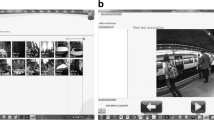Abstract
Two versions of an electronic time use diary are compared with the conventional paper-and-pencil one (or PAPI). One version was a self-administered diary (Computer-Assisted Self-Interview or CASI), while the second was based on an interviewer-administered procedure (Computer-Assisted Telephone Interview or CATI). Comparison of the data collection systems used for time use statistics revealed large differences between the procedures for most of the activities. Many of these differences were significant at the 0.05 level. Since no general effect of the registration method was found, several activities have been studied in detail to account for the differences in time use. We pay attention here only to the results for two specific activities; time spent on travel and watching television/listening to the radio. For both activities, specific registration characteristics were responsible for the differences found.
Similar content being viewed by others
REFERENCES
Andrews, F. M.: 1984, ‘Construct validity and error components of survey measures: a structural modelling approach’ Public Opinion Quarterly 48, pp. 409–422.
Andrews, F. M., J. N. Morgan, J. A. Sonquist and L. Klem: 1973, Multiple Classification Analysis. A Report on a Computer Program for Multiple Regression Using Categorical Predictors (University of Michigan, Ann Arbor).
Ès, D.: 1978, ‘Studies of time use: problems and prospects’ Acta Sociologica 21(2), pp. 125–141.
Billiet, J., G. Loosveldt and L. Waterplas: 1986, Het survey-interview onderzocht (The Survey-Interview Researched). Effecten van het ontwerp en gebruik van vragenlijsten op de kwaliteit van de antwoorden (Sociological Research Institute, KU Leuven).
Bosch, B.: 1991, De kwaliteit van een paper-and-pencil dagboek en twee vormen van een electronisch dagboek (The Quality of a Paper-and-Pencil Diary and Two Forms of an Electronic Diary). Unpublished manuscript (NIMMO, Amsterdam).
CBS: 1989, De mobiliteit van de Nederlandse bevolking (The Mobility of the Dutch Population) (Netherlands Central Bureau of Statistics, Voorburg).
Clemens J.: 1984, ‘The use of viewdata panels for data collection’ In ESOMAR: Are Interviewers Obsolete? (ESOMAR, Amsterdam), pp. 47–65
De Leeuw: 1992, Data Quality in Mail, Telephone and Face to Face Surveys (TT-Publicaties, Amsterdam).
Ekman, P. 1965, ‘Differential communication of affect by head and body cues’ Journal of Personality and Social Psychology 2, pp. 726–735.
ESOMAR: 1984, Are Interviewers Obsolete? (ESOMAR, Amsterdam).
Gershuny, J. and J. Robinson: 1992, Estimating Paid Work Time. Paper presented at the meeting of the International Association for Time Use Research, Rome, Italy, June 15–18 1992.
Groves, R. M.: 1989, Survey Errors and Survey Costs (John Wiley & Sons, New York).
Groves, R. M. and R. L. Kahn: 1979, Surveys by Telephone (Academic Press, New York).
Hochstim, J. R.: 1967, ‘A critical comparison of three strategies of collecting data from households’ Journal of the American Statistical Association 62, pp. 976–989.
Juster, F. T.: 1986, ‘Response errors in the measurement of time use’ Journal of the American Statistical Association 81(394), pp. 390–402.
Juster, F. T.: 1990, The Allocation of Time: Empirical Findings, Behavioral Models, and Problems of Measurement (Survey Research Center, University of Michigan, Ann Arbor).
Kalfs, N.: 1986, Het construeren van meetinstrumenten voor quasi collectieve voorzieningen en huishoudelijke productie (The Construction of Measurement Instruments for Quasi Collective Goods and Household Products). Research Memorandum No. 861117 (Sociometric Research Foundation, Amsterdam).
Kalfs, N.: 1993, Hour by Hour: Effects of the Data Collection Mode in Time Use Research (NIMMO, Amsterdam).
Kalfs, N. and J. van der Waard: 1994, ‘Kwaliteit van gegevens van tijdbestedings — en verplaatsingsdagboeken’ ('Quality of data gathered with time use and trip diary surveys'), In: Colloquium vervoersplanologisch speurwerk 1994, deel 3, pp. 889–906.
Kalfs, N. and W. E. Saris: 1995, The Effects of Different Data Collection Systems: A Comparison of an Electronic and a Paper-and-Pencil Diary. Submitted.
Lass, J., W. E. Saris and M. Kaase: 1997, ‘Sizes of the different effects: coverage, mode and nonresponse’ in Saris and Kaase (eds.), The Eurobarometer: Measurement Instruments for Opinions in Europe (Forthcoming), chapter 5.
Mehrabian, A.: 1968, Silent Messages (Wadsworth, Belmont).
Miller, P. V.: 1984, ‘Alternative question form for attitude scale questions in telephone interviews’ Public Opinion Quarterly 49(4), pp. 766–768, 75, pp. 534–543.
Niemi, I.: 1993, ‘Systematic error in behavioral measurement: comparing results from interview and time use studies’ Social Indicators Research 30(2–3), pp. 229–245.
NOS: 1989, Kijken en luisteren (Viewing and Listening) (Nederlandse Omroepprogramma Stichting, Kijk en Luister Onderzoek, Hilversum).
Saris, W..: 1989, ‘A Technological revolution in data collection’ Quality and Quantity 23, pp. 333–348.
Saris, W. E.: 1991, Computer Assisted Interviewing (Sage, London). Series Quantitative applications in the social sciences 80.
Saris, W. E. and M. W. de Pijper: 1986, ‘Computer assisted interviewing using home computers’ European Research 14, pp. 144–152.
Scherpenzeel, A.: 1995, A Question of Quality. Evaluating Survey Questions by Multitrait-Multimethod Studies. Royal PTT Nederland NV, KPN Research.
Tigerstedt, R. and M. Kaartama: 1984, Estimating Trip Frequency From Time Use Data. Paper presented at the 9th reunion of the Research Group on Time Uses and Social Activities, Espoo, Finland, August 8–10 1984.
Verwey, M., N. Kales, W. E. Saris and W. M. de Pijper: 1987, ‘Tijdsbestedingsonderzoek middels Tele-Interviewing en de mogelijkheid voor segmentatie’ ('Time use research by means of Tele-Interviewing and possibilities for segmentation'), Massacommunicatie 4, pp. 353–369.
Williams, E.: 1974, A Summary of the Present State of Knowledge Regarding the Effectiveness of the Substitution of Face-to-Face Meetings by Telecommunicated Meetings (Communication studies group, London, Paper no. P/74294/WL).
Williams, E.: 1977, ‘Experimental comparison of face-to-face and mediated communication: A review’ In Psychological Bulletin 84, pp. 963–976.
Woltman, H.F., A. G. Turner and J.M.A. Bushery: 1980, ‘Comparison of three mixed mode interviewing procedures in national crime survey’ In Journal of the American Statistical Association.
Author information
Authors and Affiliations
Rights and permissions
About this article
Cite this article
Kalfs, N., Saris, W. Large Differences in Time Use for Three Data Collection Systems. Social Indicators Research 44, 267–290 (1998). https://doi.org/10.1023/A:1006898222519
Issue Date:
DOI: https://doi.org/10.1023/A:1006898222519




